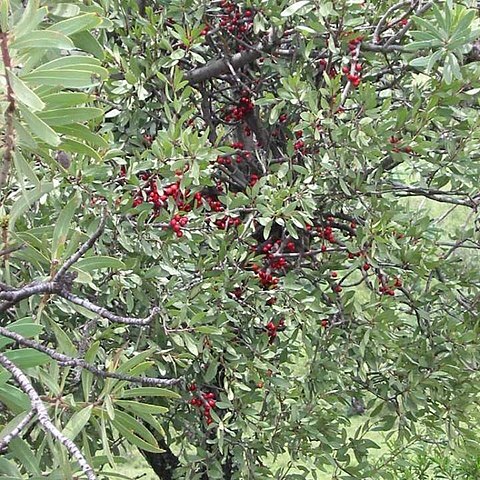Corolla tube 3.5–4.5 cm long, red with whitish spots, head of buds yellowish-or greenish-white, darkening, puberulent with short spreading hairs up to 0.2 mm long; bud heads 3.5–5 × 2.5–3 mm, oblong-ellipsoid to oblong-obovoid, rounded, sometimes slightly apiculate, somewhat angular and sometimes slightly ribbed; basal swelling 4.5–6 × 3.5–5 mm, ovoid or ovoid-ellipsoid, tube constricted for 3–5 mm above; lobes 9–10 mm long, reflexed, the upper expanded part 4–5 × 1.5 mm.
Shrub, up to 1 m high, hemiparasitic. Leaves at maturity shortly petiolate; blade ovate-elliptic, 30-45 x 10-20 mm; petioles up to 3 mm long. Flowers: in 3-or 4-flowered umbels solitary in leaf axils; corolla 35-40 mm long, puberulent, dull pink with whitish spots, light green at apex and base; Aug.-Dec. Fruit ellipsoid, 10-12 mm long, reddish orange.
Leaves mostly opposite; petiole 2–13 mm long; lamina coriaceous, dull green to glaucous, 3–9 × 0.8–5(7) cm, lanceolate to ovate-elliptic or ovate, subacute to rounded at apex, cuneate to rounded at base, generally glabrous, with 4–8 pairs of lateral nerves, the middle ones rather more ascending.
Shrub, up to 1 m high, parasitic on species of Acacia, Aloe, Combretum, Maytenus etc. Leaves at maturity shortly petiolate, glabrous. Corolla with tube swollen at base, lobes reflexed, puberulent. Flowers with corolla tube dull pink with whitish variegations, light green at apex and base.
Stem parasite, up to ± 1 m tall. Leaves mostly ovate-elliptic, but highly variable. Flowers 3 or 10 cm axillary clusters, tubular, base conspicuously swollen, mouth deeply V-shaped, 5 lobes reflexed, reddish pink with green at base and tips. Berry reddish orange. Year-round.
A shrub that grows on other plants. It can grow 1.5 m high. Young stems are hairy. The leaves are arranged irregularly. The leaves vary but can be 3-5 cm long by 1-2 cm wide. Flowers occur in single groups of 3-4 flowers. The fruit are oval berries. They are reddish-orange.
Umbels 1–several per axil, (2)4-flowered, puberulous; peduncle 1–2(4) mm long; pedicels 0.5–2 mm long; bract 2–2.5 mm long, shallowly cupular, with a small triangular limb.
Stems spreading to 1 m or so, generally puberulous at first, glabrescent, grey to brownish, densely but inconspicuously lenticellate.
Berry red, 8–9 × 5–7 mm, ellipsoid, with short persistent calyx, glabrescent.
Calyx 1–1.5 mm long, saucer-shaped, truncate to slightly toothed, puberulous.
Stamen filaments red; tooth 0.7–0.8 mm long; anthers 2.5–3 mm long.
Style with neck 2.5–3 mm long; stigma 0.7–0.8 mm across, capitate.
Receptacle 1.5–2 mm long.

